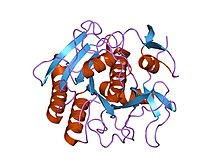Proteinase K
| Proteinase K | |||||||||
|---|---|---|---|---|---|---|---|---|---|

Structure of Proteinase K.
|
|||||||||
| Identifiers | |||||||||
| EC number | 3.4.21.64 | ||||||||
| Databases | |||||||||
| IntEnz | IntEnz view | ||||||||
| BRENDA | BRENDA entry | ||||||||
| ExPASy | NiceZyme view | ||||||||
| KEGG | KEGG entry | ||||||||
| MetaCyc | metabolic pathway | ||||||||
| PRIAM | profile | ||||||||
| PDB structures | RCSB PDB PDBe PDBsum | ||||||||
|
|||||||||
| Search | |
|---|---|
| PMC | articles |
| PubMed | articles |
| NCBI | proteins |
In molecular biology Proteinase K (EC 3.4.21.64, protease K, endopeptidase K, Tritirachium alkaline proteinase, Tritirachium album serine proteinase, Tritirachium album proteinase K) is a broad-spectrum serine protease. The enzyme was discovered in 1974 in extracts of the fungus Engyodontium album (formerly Tritirachium album). Proteinase K is able to digest hair (keratin), hence, the name "Proteinase K". The predominant site of cleavage is the peptide bond adjacent to the carboxyl group of aliphatic and aromatic amino acids with blocked alpha amino groups. It is commonly used for its broad specificity. This enzyme belongs to Peptidase family S8. The molecular weight of Proteinase K is 28,900 daltons (28.9 kDa).
Activated by calcium, the enzyme digests proteins preferentially after hydrophobic amino acids (aliphatic, aromatic and other hydrophobic amino acids). Although calcium ions do not affect the enzyme activity, they do contribute to its stability. Proteins will be completely digested if the incubation time is long and the protease concentration high enough. Upon removal of the calcium ions, the stability of the enzyme is reduced, but the proteolytic activity remains. Proteinase K has two binding sites for Ca2+, which are located close to the active center, but are not directly involved in the catalytic mechanism. The residual activity is sufficient to digest proteins, which usually contaminate nucleic acid preparations. Therefore, the digestion with Proteinase K for the purification of nucleic acids is usually performed in the presence of EDTA (inhibition of calcium-dependent enzymes such as nucleases).
Proteinase K is also stable over a wide pH range (4–12), with a pH optimum of pH 8.0. An elevation of the reaction temperature from 37 °C to 50–60 °C may increase the activity several times, like the addition of 0.5–1% sodium dodecyl sulfate (SDS) or Guanidinium chloride (3 M), Guanidinium thiocyanate (1 M) and urea (4 M). The above-mentioned conditions enhance proteinase K activity by making its substrate cleavage sites more accessible. Temperatures above 65 °C, trichloroacetic acid (TCA) or the serine protease-inhibitors AEBSF, PMSF or DFP inhibit the activity. Proteinase K will not be inhibited by Guanidinium chloride, Guanidinium thiocyanate, urea, Sarkosyl, Triton X-100, Tween 20, SDS, citrate, iodoacetic acid, EDTA or by other serine protease inhibitors like Nα-Tosyl-Lys Chloromethyl Ketone (TLCK) and Nα-Tosyl-Phe Chloromethyl Ketone (TPCK).
...
Wikipedia
